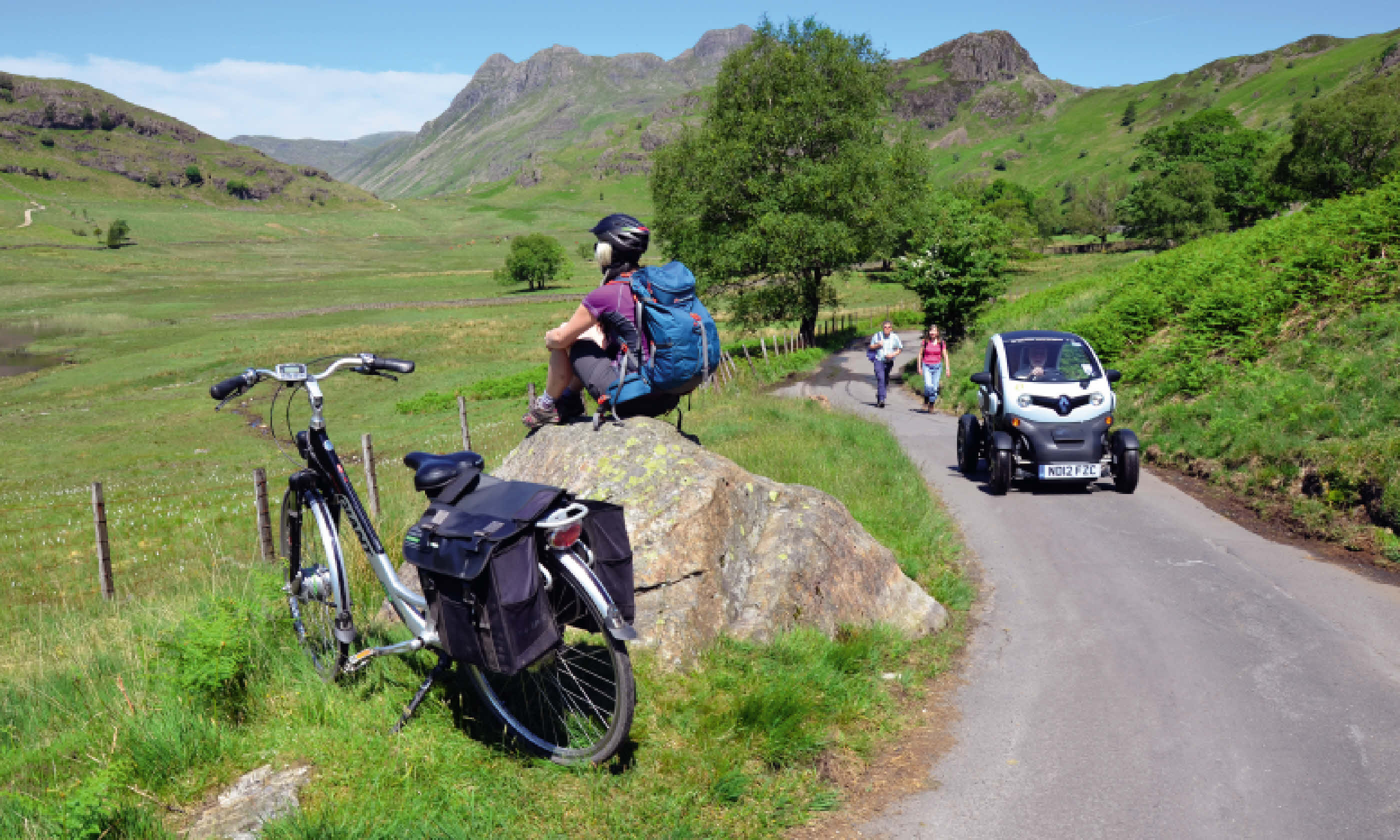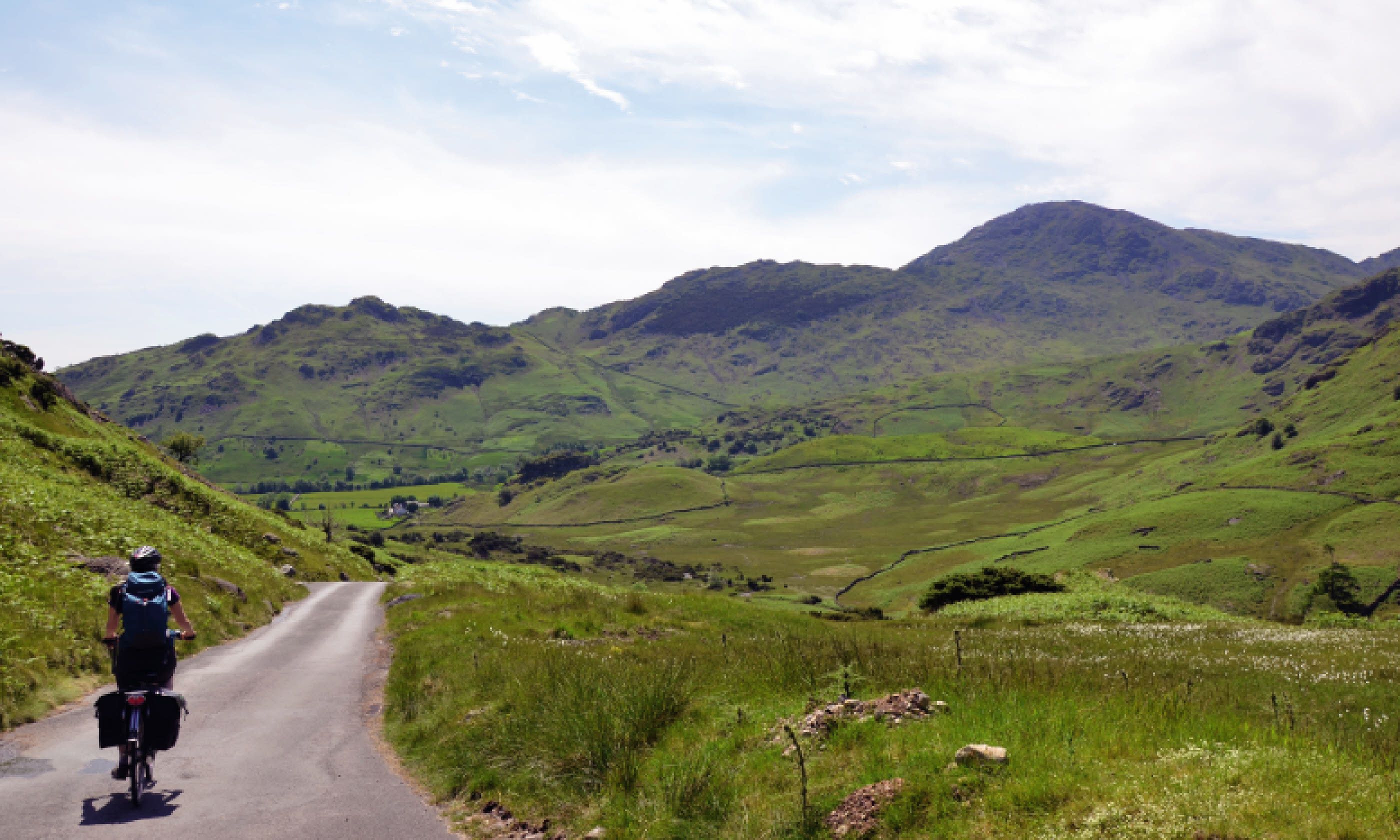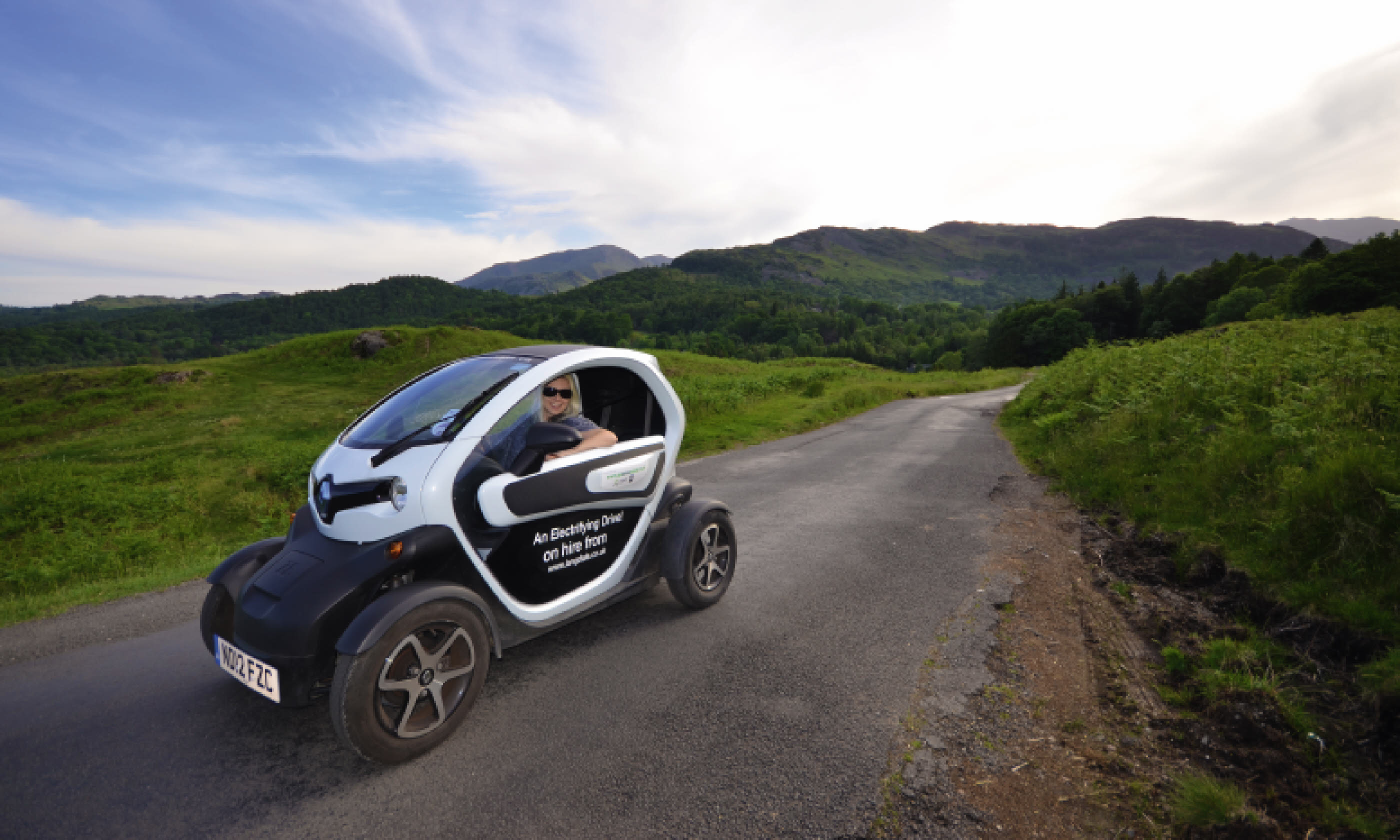
Exploring the Lake District by electric bike
With its electric cars, bike-friendly buses, boats, trains and trails, the Lake District is also one of the best places for a great green adventure
The Lake District is a great many things to a great many people. To the Romans it was the stronghold from which they could plot their takeover of Scotland. For the poet Wordsworth, it was a daffodil-dotted muse. But for me the Lakes has always meant one thing and one thing only: hills, and lots of them.
As a keen walker, I dream of dancing along the rocky ridge of Striding Edge; of skirting the endless tarns and waters that freckle the landscape; of standing on top of Scafell Pike, the highest peak of all, admiring the views. It’s just a shame that accessing those beautiful places means having to navigate so many winding roads by car. Or does it?
When someone suggested I try a car-free Lakes trip, I was unconvinced. But just a couple of weeks later I found myself not only there minus my vehicle but on a bicycle, heading straight for a fairly steep incline. “Turn it up to Sport mode!” shouted Greg as he started the climb on his normal push bike, grinding slowly and working up a sweat. Watching his effort, I was fearful. But then, the bike I was pedalling harboured a rather nifty addition – an electric motor.

Fumbling with the mini dashboard I changed the power supply from Eco to maximum-assistance setting. The battery kicked in and, though I had to continue pedalling to move, I made my way up the hill with ease, overtaking Greg and still managing to hold a conversation without hyperventilating.
“They make you think you’re fitter than you are, don’t they? Gives you quite a boost psychologically,” said Lakelander Greg as we sipped coffee at the café on the shores of Coniston half an hour later. The electric bike network has been steadily growing here since it was first introduced in 2012. Now there are 19 hire points and 30 re-charge stations – from Keswick in the north to Grange-over-Sands in the south, Ravenglass in the west to Kendal in the east.
Visitors are slowly coming around to the idea that a visit to northern England’s most famous national park can be done without a car, even if you’re not a Wiggins on two wheels. “It’s a case of joined-up thinking,” explained Greg. “We wanted to prove that it’s physically possible to visit the Lakes without a car – using trains, buses, boats, boots and bikes.”
Hiking highs
I’d tried four of these methods already. I’d started in London, taking the fast train that runs from Euston to Oxenholme in just three hours. I caught a connecting train to Windermere, then a bus to Elterwater in Great Langdale, my base for a few days’ exploring. It was a smooth start, with my time on the train spent winding down rather than getting angry in traffic. Before I got the bike, I’d had Sunday to explore the Lakes by the only means at my disposal – my feet.
Pulling on my walking boots I headed off on one of the many paths through Elterwater, tracing the river down to a paddock full of brown cows. Here the Langdale Valley was perfectly framed by overhanging tree branches, the hulking spikes of the granite Langdale Pikes peeking over the water’s edge in the distance. Continuing to Skelwith Bridge I had two options: an early lunch by the river or a yomp up onto the fells.
As if in answer to the question, late-morning rays illuminated the little knobbly peak of nearby Loughrigg Fell, inviting me onwards. I strolled easily up to its summit, the lose rocks beneath my boots crunching as I went. Standing by the trig point on top, the surrounding hills seemed to radiate out like fan blades. The air smelt of wet grass as the wind whipped the clouds into dramatic grey curtains. Retracing my steps I made a beeline for Chesters by the River, to gorge on courgette cake and a giant cup of hot chocolate.
Even after I’d finished my feast, it was too early to head straight back to Elterwater, so I started to walk. Following my nose I strolled along the road until I saw a signpost for Ambleside. Sat at the northern end of Lake Windermere, this, an informal capital in Lakeland, is home to a busy hub of outdoor shops, cafés and one of the best vegetarian-restaurants-cum-cinemas around.
Normally, a journey there involves a mildly frustrating drive following farm traffic and getting caught in the one-way system. This time I was climbing up among the fells, following an old packhorse route. As it converged with several other hillside paths, it felt as though a whole new network had suddenly opened up to me. I followed these old trails from village to village. They were not only shorter in distance than the tarmac strips that cut through the valleys, but also more picturesque, more historic and more intuitive. By the time I arrived in Ambleside I felt like I’d walked through time.
Fells at full throttle
When Greg delivered the electric bike the following morning I was initially reluctant to abandon my walking boots. However, after mastering the controls and zipping up hills like a pro to the comforting ‘hum’ of an almost-silent motor I was an instant cycling convert.
While we sipped tea at Coniston, Greg gestured to the hut where a fleet of e-bikes were kept. Scores of curious people, including a couple of families, were gathered around them. “The great thing is that electric bikes are attracting non-cyclists,” said Greg. “Those who already love cycling are never going to want to use them, but for those people intimidated by the idea of relying on pedalling in a place as hilly as the Lakes, these bikes will hopefully encourage them to try it. And if that means taking their cars around the Lakes less, it can only be a good thing.”
With that we jumped back on our wheels and began our tour around Coniston. Wooden boats with bright-red sails bobbed on the water. Steamboats shot white plumes through their coal-black funnels, chugging along beside us, while a family paddled through its wake in kayaks. I’d looked down at this landscape many times before from high above on the fells, and I’d driven past in a car, but now on my bike I really felt part of it.
You notice more on a bike and, unlike in a car, you can stop whenever and virtually wherever you like. Also, on an electric bike, without the worry or pain of hills and distance I could actually concentrate on the views. Like staring at the moody Old Man of Coniston, which seemed to be commanding clouds around its summit like a sorcerer. Or stopping to sit and dangle my legs from the old wooden pier near Brantwood. Or admiring the Antony Gormley statue at High Nibthwaite – something I’d never taken the time to notice before. At the end of the day I felt like I’d seen more, taken in more, and covered more ground than if I’d been walking. It felt good to do something kind of healthy and with a clean, green conscious.
Eco auto
Things were about to get greener. A dusky pink light illuminated the sky as we cycled into Elterwater, but it was something else that caught my eye – a Twizy. These little electric cars are powered by solar energy, making them as green a ride as you can get. And I was rather keen to try one out. I had a meal booked in Grasmere, which meant either a steep cycle or walk up over Red Bank – sure to be thigh-busting even with an electric bike – or a much longer 14km cycle via Ambleside. The Twizy offered me an easy alternative.
Minutes later I was climbing up the aforementioned Red Bank with just a foot on the accelerator. With a top speed of around 28mph and open gaps instead of side windows, driving the Twizy was like riding a go-kart, and twice as fun. Everyone I passed did a double take or chuckled uncontrollably.

After a meal full of locally sourced, organic ingredients at the bohemian Jumble Room, it was back to Elterwater by Twizy. En route, I stopped to admire the reflections on Grasmere Lake (it’s easier to pull over in such a small car), and was showered with smiles from the passers-by in Ambleside. The whole experience seemed a bargain given the mere £10/hour rental cost.
A place to recharge
I woke the next morning to a warm breeze blowing through the window. Now relishing rather than dreading the idea of pulling on my cycling shorts I went outside to meet Isobel Stoddart from the Electric Bicycle Network, who is actively promoting the Lakes is a world-class cycling destination.
“Four years ago people didn’t see the Lakes as a place to bike – unless they were already keen cyclists. But now, with electric models, people are coming round to the idea,” Isobel told me as we began pedalling. “We want to make bike rentals connect with trains so eventually, in theory, someone could arrive by train, pick up a bike and cross the Lakes from one side to the other.”
As Isobel was explaining her car-free Lakes plan, we passed our first Beatrix Potter farm of the day. Known best for
The Tale of Peter Rabbit, the author was also key in protecting swathes of land now incorporated into the Lake District National Park. A keen conservationist – of both land and the traditional way of farming – on her death Potter left the National Trust her 16 farms, cottages and over 4,000 acres of land.
We stopped to take in Yew Tree Farm, where an amorous turkey took a liking to my panniers and began parading around in all his feathery splendour to impress them. Moving on, we cycled into Hawkshead – a Potter stronghold – with its gallery of her paintings. From there we made our way up to the most famous of her houses – Hill Top House in Sawrey. It is now a recharge point on the cycle network. As a woman hell-bent on preserving a greener lakes, Potter would surely have approved.
From the hilly highs of Hawkshead to the gentle shores of Lake Windermere, we pedalled along the lakeside trail to Wray Castle and watched the electric boats put-putting along – another link in the Lakes’ car-free network. We finished at a country pub called The Drunken Duck, surrounded by fells in all directions. It’s another place to charge your batteries in all senses – there are plug-ins for your bike and sandwiches for your belly, which of course you earn all the more when travelling without your car.
Bidding farewell to Isobel I pedalled slowly back towards Elterwater. I explored smaller roads closed off to cars and a series of bike-friendly tracks over rivers; I even stumbled across the dramatic Cathedral Cave in the disused quarry in Little Langdale. As dusk began to descend I turned on my headlight and ventured deeper into the Langdale Valley for the real ale and local dishes at the National Trust owned Sticklebarn.
After I’d eaten, the barman offered to call a taxi but, with the bike waiting patiently outside, why would I bother? That night I cycled home with a smile on my face, my food carbon-footprint free, my transport green, the calories from my hearty meal being burned off with each turn of the spokes. Now, as my light beam cut through the darkness ahead I thought about just how much of the national park I had seen without stepping foot in a car. So yes, the Lakes is many things to many people; now, for me, as well as a place of poetry-inducing fells, it is one of the UK’s best car-free destinations.
Make it happen: The author stayed at the Langdale Estate’s Brimstone Suites in Elterwater, Greater Langdale (015394 38062). Rooms feature log-burning stoves; you get your own host and a cooked breakfast brought to your room in the morning. There’s also a reading room with complimentary drinks and snacks, and a boot room stocked with gear from Berghaus, which is free for guests to use.
All images: Neil S Price


